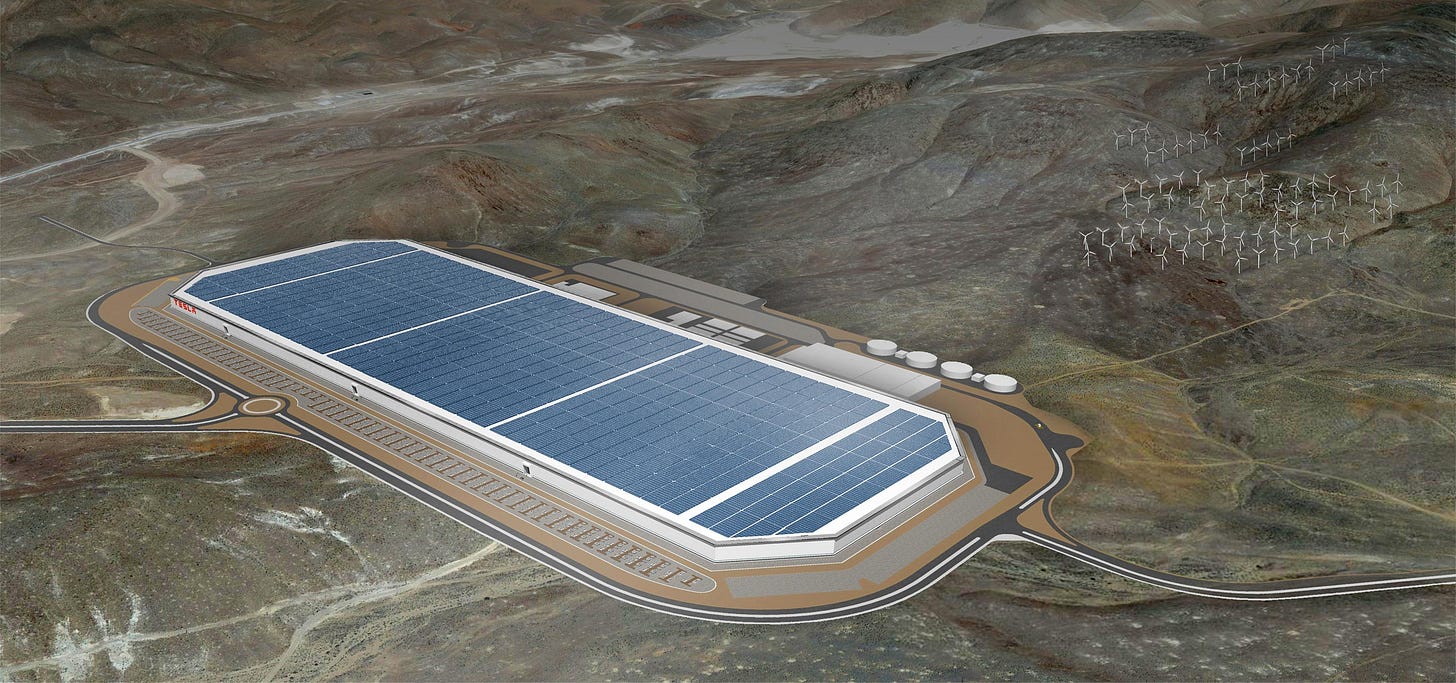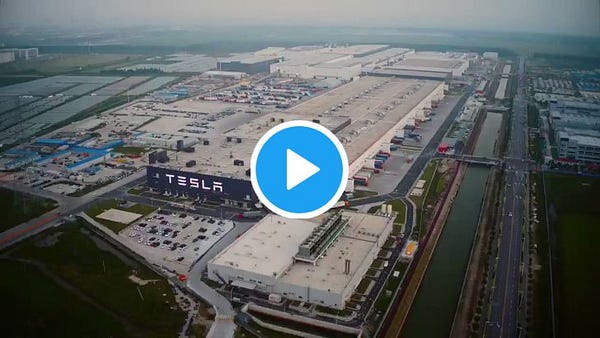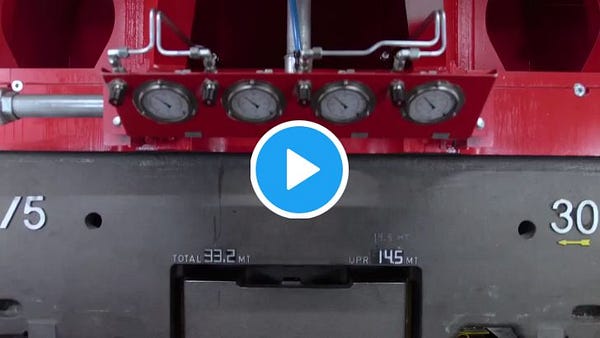This week in Product | Strategy | Innovation we will continue a series of updates on Elon Musk’s vision for a sustainable energy future. Prior updates on Tesla have covered Energy Reimagined [U7], Advanced Battery Technology [U8] and AI at the Edge [U9]. This update will cover Advanced Manufacturing AKA the machine that builds the machine. Elon Musk has stated that even though Tesla leads battery technology and AI for electric vehicles (EVs), these technologies will advance by other companies to reduce Tesla’s leadership gap. But as Tesla continues to advance their manufacturing technology and processes at scale, this will be much harder to replicate by competitors. Tesla will be able to maintain a gap that others cannot close as long as the operating leverage of capital improvements enables ongoing investment into these operations.
These may change over time, but I see 4 key domains for Tesla’s Advanced Manufacturing with continuous improvement allowing all 4 to further advance over time by eliminating, improving, accelerating and simplifying processes:
Giga Factories
Mega Machines
Advanced Robotics, Additive Manufacturing & Automation
Vertical Integration
1. Giga Factories
The scale of Tesla Giga Factories was defined with the launch of Gigafactory 1 to manufacture 2170 lithium ion battery cells through a partnership with Panasonic. These on-site manufactured cells are then packaged by Tesla into multi-cell modules and packs for final assembly into vehicles in the Fremont, CA factory or other Giga Factories. Giga defines gigawatt-hour (GWh) manufacturing capacity on an annual basis. Tesla broke ground on Gigafactory 1 (AKA Giga Nevada) in June 2014 just outside Sparks, Nevada near Reno. In mid-2018 the annual run rate for battery manufacturing capacity reach 20 GWh making it the highest-volume battery manufacturing plant in the world. Giga Nevada is only partially complete with about 5.3 million square feet of operational space.
Tesla Gigafactory 2 is located in Buffalo, NY and manufactures clean energy generation (solar panels, Solar Roof) and battery storage (residential Powerwall, commercial and utility-scale Megapack). Tesla Gigafactory 2 (AKA Giga New York) has 1.2 million square feet of space with about 800 clean energy jobs. Tesla has an agreement with the State of New York to create 5,000 clean energy jobs in the state over 10 years with many of those employed at this site.
Tesla Gigafactory 3 (AKA Giga Shanghai) is located outside Shanghai, China. Tesla (Shanghai) was established May 8, 2018 with authorized capital of 100 million yuan with 100% ownership by Tesla Hong Kong. Tesla (Shanghai) is the only wholly owned automotive manufacturing company in China by a foreign company. The standard business model in China requires foreign companies to partner with a local entity and share ownership of the China operations. China has over 100 EV companies, but primary focused on the domestic market in China. Tesla entering China provides needed competition to force Chinese EV companies to first survive the threat of Tesla in China and transition into global automotive companies.
Giga Shanghai site grading started in December 2018 with a ground breaking ceremony January 7, 2019. The factory received a "comprehensive acceptance certificate" on August 19, 2019. General assembly of the Tesla Model 3 started in October 2019 just 10 months after site grading started. Giga Shanghai was built for approximately 65% of the capital expenditure per unit of manufacturing capacity compared to Model 3 final assembly in the US. This knowledge and process improvement can then be carried forward to each Gigafactory that follows. Giga Shanghai started Model Y production in 2021. As Giga Shanghai scales it can serve the needs of the Asian market for the Model 3, Model Y and a future lower-priced EV designed in Shanghai for the Asian market.
Tesla Gigafactory 4 (AKA Giga Berlin) started construction in Grunheide, Germany in June 2020. This factory will serve the needs of the European market and source engineering talent from Berlin. Model Y production will be prioritized initially and then expand with Model 3 and lower-priced EV designed in Berlin for the European market. Giga Berlin is also expected to built out 4680 cell production and pack assembly on-site with these cells initially supplied from Tesla’s 4680 pilot production facility in Fremont, CA. Tesla aims to have Model Y production starting before the end of 2021 at Tesla Berlin.
Tesla Gigafactory 5 (AKA Giga Texas) started construction just outside of Austin, Texas in July 2020. Tesla aims to have Giga Texas producing Model Y vehicles by the end of 2021. This factory is also expected to be the main factory for the Tesla Cybertruck and Tesla Semi and also produce the Model 3 and Model Y for the eastern half of the US. The Giga Texas site occupies about 2,400 acres with more extensive plans for a campus than other sites to date. It is anticipated that Austin will eventually become the corporate headquarters for Tesla with more favorable tax and residential conditions than California and the University of Texas at Austin serving Telsa’s needs to build local engineering talent. Tesla has indicated they will need over 10,000 people at the Giga Texas location by the end of 2022. Giga Texas is also expected to build out 4680 cell production and pack assembly on-site with these cells initially supplied from Tesla’s 4680 pilot production facility in Fremont, CA.
The original Tesla Factory is located in Fremont, CA with over 5.3 million sq ft of manufacturing and office space on 370 acres of land with over 10,000 employees working at the site. The site was originally owned by General Motors from 1962 through 1984. Ownership transitioned into a partnership between General Motors and Toyota to form New United Motor Manufacturing, Inc. (NUMMI) from 1984 through 2009. Tesla purchased the facility in 2010 from Toyota with cash and Tesla stock and invested significantly into the facility to produce the first Model S in June 2012. The facility now produces Model S, Model X, Model 3 and Model Y. A satellite Tesla facility is located nearby on Cato Road that produces Tesla seats for its vehicles. This is also the site for the 4680 battery cell pilot factory.
2. Mega Machines
Tesla uses the scale of its factories to drive efficiencies during final assembly with more automated production on-site of components as single parts early in the process to eliminate the need for sub-assembly of multiple parts before final assembly. This saves time and money even if sub-assembly is fully automated. As unit production volumes scale, these efficiencies have an even greater impact on creating operating leverage. That leverage can be used to increase profits or reduce the price of the manufactured product to drive even more demand.
One example is the automated stamping machines that form exterior body parts out of blank sheets of aluminum. These are a key feature in all the Tesla factories for final assembly of electric vehicles. The upcoming CyberTruck with its hard stainless steel exoskeleton will provide new manufacturing challenges. But with the exoskeleton shaped from a single hard sheets of cold-rolled stainless steel or cast as one exoskeleton part, the cost and time benefits could be huge.
The Giga Press is the nickname for Tesla’s new 6,000 ton high pressure die casting machines sourced from IDRA Group in Italy. These are the largest die casting machines ever constructed in the world. The machines enable Tesla to cast one large part like an underbody segment vs. many parts that must be welded together to make the same underbody segment. However, for this to work, Tesla had to create new metal alloys to cast such large parts. Material scientists and engineers are shared between Tesla and SpaceX and they were likely critical to this project. Munro and Associates analyzed the alloy composition of these Tesla Model Y large chassis parts and determined the alloy is 89.5% aluminum 8.5% silicon plus traces of copper, manganese, iron and magnesium.
The Giga Press is operational in Giga Shanghai and the Tesla Factory in Fremont, CA but is currently only casting the rear underbody segment for the Model Y. This will expand to include the front underbody segment and the mid-chassis structural battery. Giga Berlin and Giga Texas are under construction now and foundations for multiple Giga Presses are included. Giga Berlin will have at least 8 of these Giga Presses. Giga Texas ordered the world’s first 8,000 ton die casting machine on March 16, 2021 from the IDRA Group. This is expected to be used for the rear body segment of the new Tesla Cybertruck.
3. Advanced Robotics, Additive Manufacturing & Automation
Tesla Gigafactories are known for their level of automation with advanced robotics. Key robots are named after X-Men like Wolverine, Professor X, Iceman and Beast. Even with all the automation, around 10,000 employees still work at Tesla’s factory in Fremont, CA. Employees work with robots to manufacture Tesla vehicles. But as advanced robotics improve in specialized manufacturing lines to make key components like the new 4680 battery cells, more automation will require fewer employees in these areas.
Tesla acquired German automation company Grohmann Engineering in late 2016. This gave Tesla access to key German engineering talent already working to automate car production. With this acquisition Tesla could deploy these resources internally to drive more vertical integration and accelerate designs for advanced production lines to continuously automate and improve more processes. Since the Grohmann Engineering acquisition, Tesla has also acquired firms like Perbix, Compass Automation and Hibar Systems to improve automated manufacturing. These are often “acquihires” of key engineering talent.
Prototyping, tooling and specialty parts have benefited with advances in additive manufacturing (AM) also known as 3D printing. This technology is advancing fast with growing adoption in the aerospace and medical device industries for specialty parts, but is still too expensive for most commercial parts in the automotive industry. But automotive companies are working to incorporate more AM into commercial production and as prices come down the use will only accelerate. The concept is similar to the Giga Press where large parts are cast using a molten metal alloy and mold to form a custom part. AM can make very complex parts that are less feasible with other methods.
The Volkswagen Group is an early adopter of AM for tooling, commercial parts and replacement parts for classic cars in its luxury brands like Porsche. The company has reported that they have switched tooling production almost entirely to AM. And the Volkswagen Group also uses AM in their motorsports group to accelerate the production of new concepts for specialty racing events like Pikes Peak in Colorado. Caterpillar is also an adopter of AM to fabricate aluminum and titanium parts. Replacement parts for older machines is a common use case at the company. Leading companies in the additive manufacturing industry include 3D Systems, Desktop Metal, HP, Materialize, MarkForged and Stratasys. And Protolabs is a large outsourced AM company.
Advanced robotics and additive manufacturing incorporate automation into these processes, but automation alone can streamline production in other areas like Tesla’s emerging 4680 battery cell production line. Tesla studied high volume production in mature industries like printing newspapers and bottling lines to identify key principles. The end result is an expected 7x increase in production and 75% reduction in cost per GWh of 4680 lithium ion battery cells.
4. Vertical Integration
Tesla’s competitors in the automotive industry have outsourced almost every function to manufacture vehicles except final assembly into a finished product and just one key component, the internal combustion engine. All other functions are outsourced including sales distribution through automotive dealers who may stock competing products. Tesla has vertically integrated manufacturing for most of its key components and intends to go even deeper into their supply chain in the future to source raw materials for battery cells, manufacture the battery cells, assemble structural battery cells into the chassis, cast the front and rear underbody segments, make their own car seats, make their own electric motors and sell their products direct to consumers and businesses using the Tesla mobile app or website.
Tesla also acquires manufacturing and consulting companies to access technology and talent to help accelerate vertical integration. This also means Tesla is more vulnerable if the overall economy goes through a downturn because they have more people and processes carried on their operations. Therefore, Tesla needs to use the leverage it creates with vertical integration to lower manufacturing costs and pass those savings on to the end user with lower prices. This allows Tesla to create more demand for its vehicles and capture most of the margin for its own operations.
Elon Musk refers to its manufacturing as the “machine that builds the machine”. Key processes that are required to manufacture Tesla’s products and services are seen as an opportunity to improve the process to gain efficiency. Constructing new Giga Factories is done by other firms, but Tesla has built knowledge around these designs and processes and is very involved here, too. Tesla will continue to integrate this knowledge into its operating teams to keep upgrading and expanding these facilities with growth. Tesla even builds its own software internally including enterprise software that runs the company instead of competing products from SAP or Oracle.
Best,
Stephen
Nothing in this post is intended to serve as financial advice. Do your own research. I’m long TSLA and SSYS mentioned in this update.













